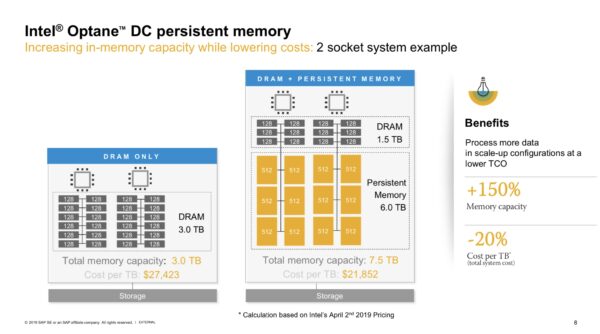Two numbers stick out to me: 65% of the cost of DRAM and 90% of the performance. Especially, if like me, you deal with in-memory workloads such as SAP HANA. These were the numbers Pure Storage shared during Tech Field Day Extra (TFDx) at their user conference Pure Accelerate. Why is this important, and what should you ask to flush out the details further? I’m glad you asked.
During SAP TechEd, I sat down with an Intel spokesperson to ask about the business value of their storage class memory (SCM) solution under the Optane brand. Whether you are placing these DIMM-form memory modules inside of servers or storage arrays, the theme is more performance for less money.
Optane storage class memory leverages flash storage that has lower latency than traditional flash and cheaper than DRAM. That combination means an application such as SAP inherits the capability to have more memory at a lower price point. According to Intel, as of May 2019, a 2-socket system has 150% more memory capacity at 20% less cost per TB.

What are the business outcomes? How about the ability to analyze more data faster at the same cost as current systems? In other words, increased productivity as a result of increased performance at a reduced price. We expect this type of innovation from Intel given the tradition of Moore’s Law. The question is, how does Pure Storage improve upon the base capability?
Shared Direct Memory
Pure Storage announced support for Intel Optane Persistent Memory in their FlashArray storage. Server OEMs can improve the performance of SAP HANA in ways that matter beyond faster analytics. Let’s say a company’s cost for SAP HANA downtime is $100K/hour. After maintenance, loading a 6TB SAP HANA DB takes about 50 minutes. In the same system with Intel Optane Persistent Memory, the database loads in 4 minutes. That’s about $100K in savings anytime a HANA system is restarted for maintenance. When I managed SAP for a large organization, we took the system down twice a year. That’s right around $200K in real savings.
Not every organization has that scale or budget. That’s where the Pure Storage FlashArray with Intel Optane Memory comes into play. By placing the storage class memory in a shared array, administrators have the option of applying that performance gain directly to systems such as SAP HANA or overall storage performance. SAP shows an OEM server savings of 20% vs. Pure Storage’s claimed savings of 65%. In other words, pooling costly resources between systems brings down the average cost per performance. Therefore, there’s no reason for me to question Pure Storage’s claims. Pure Storage’s claims sound a lot like the typical argument for shared storage.
The CTO Advisor’s Take
There’s no free ride. Pure Storage’s stat of 90% performance at 65% of the cost of DRAM is impressive on face value. These are relatively new capabilities. Looking at SAP, you must be on SAP HANA version 2.3 or later. SAP and Intel have spent three years working on improving the performance of the in-memory database with Intel Optane. These performance increases don’t equally translate to other in-memory systems such as Redis and Oracle Exadata.
In the case of Exadata, Oracle announced a 10X reduction in latency compared to previous versions of Exadata. Oracle didn’t share what that reduction in latency means from a business outcome or application performance. Likewise, Redis is a very vague application performance improvement of Intel Optane equipped systems. Taking a swag at the potential performance increase for these other in-memory DBs on Pure Storage’s offering is difficult if not impossible today.
If you are considering Optane modules for your FlashArray, keep that consideration in mind. On paper, there is an apparent benefit. In practice, get more data before you make the architectural decisions on using this configuration in-memory databases.

